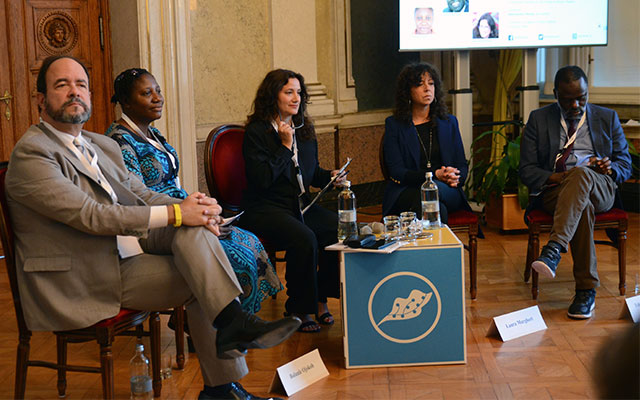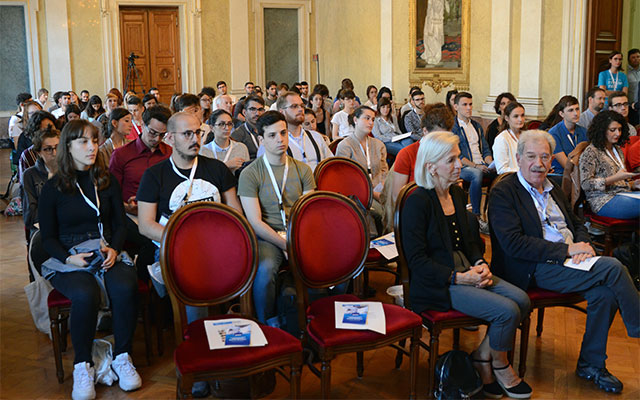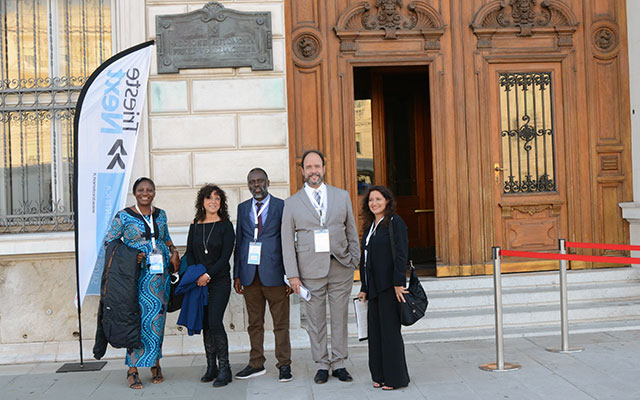
We should not fear artificial intelligence and robots as they have no consciousness. Rather, we should be afraid of humans who find ever new ways to put society at risk.
This provocative thought was among the threads of a discussion on benefits and potential risks of the Fourth Industrial Revolution during a vibrant roundtable organized by TWAS at the 2019 edition of Trieste Next. The international science festival every year brings about 50,000 visitors to Trieste, Italy, including scientists, journalists, professionals, policymakers, students and others interested in science and related issues.
This year's event, held 27-29 September, was titled "Big Data, Deep Science". TWAS assembled a roundtable to explore "The promise – and risk – of the Fourth Industrial Revolution," held before an overflow crowd of 150 people in the elegant Salone di Rappresentanza located in the Palazzo di Piazza Unità, Regione Friuli Venezia Giulia.
"AI is neither good nor bad. It is a very powerful tool that can offer guidance in various fields: to predict future wars, to make precise medical diagnosis and to enhance efficiency in trades," observed Tshilidzi Marwala, vice chancellor and principal at University of Johannesburg, South Africa.
Marwala, an elected TWAS Fellow, was joined on the panel by Bolanle Ojokoh, an associate professor in the department of information systems, Federal University of Technology, Akure, Nigeria; Fernando Buarque, head of the Computational Intelligence Research Lab at the University of Pernambuco, Brazil; and Laura Margheri, an expert in bioinspired robotics, and soft robotics research, with the Center for Micro-BioRobotics of the Istituto Italiano di Tecnologia in Pisa, Italy. TWAS Executive Director Romain Murenzi welcomed the audience, and Italian journalist Alessandra Ressa served as moderator.
The event offered all-round points of view on the scenarios opened by the Fourth Industrial Revolution, an era where human capacities blending with pioneer technologies and impacting on everyday life may compel us to reconsider the very idea of human being.
Robotic life, Marwala added, is around us in forms that do not seem threatening because they do not recall humanoid figures. He explained: "Robots are routinely used to perform repetitive, dangerous or complex tasks: in hospitals as drug dispensers; in food production and restaurants, to store and prepare foods; and in the fight against criminals, to avoid exposing policemen to the threat of a criminal."
And even if we can use AI machines to monitor infrastructures conditions or in the decision-making process when epidemics occur, he warned, "we first need to nurture future generations on its power, starting with young children and school students."
Serving developing countries
Since its earliest steps, the human species has undergone several technological revolutions, Buarque said in his presentation. From the condition of tool makers we have developed a society where people "made tools for making other tools". And from this status we moved on to a more advanced orientation, where computers and software tools were used "for planning to make tools".
This has opened up a number of potential advancements: "Smart machines imitating intelligent human behaviour are now used to solve problems through complex algorithms," observed Ojokoh. "This allows applications in fields as agriculture, food security, disaster preparedness and environment management."
Ojokoh, an executive board member of the TWAS Young Affiliates Network (TYAN), is an expert in intelligent information filtering, retrieval and extraction, with further application of these to web mining, the process that allows discovery of specific patterns in an apparently random set of data from the web.
As an example of AI and data management in agriculture, Ojokoh cited a project involving Nigeria and Benin, for which she is seeking funds. "Production from subsistence agriculture is currently at the mercy of factors like weather conditions, particularly rainfall, pest activities, and soil quality," she explained. Since climate change affects the duration and quantity of rain and also impacts pest patterns, one way out for farmers would be developing strategies to adapt to these changes.
"Our research will use big data to find out where these diverse challenges are most felt by farmers," she said, "with the purpose of helping farmers to learn what they should expect from placing a farmland in one location rather than in another." And she concluded: "With proper reading of huge amount of data, we could even advise policy makers and help them devise better plans."
Mimicking nature
To move in real-world environments, we need robots able to promptly adapt to changes and to move with an energetically efficient strategy, as natural organisms do. Laura Margheri works for the Bioinspired Soft Robotics research line at the Istituto Italiano di Tecnologia (IIT), where nature is taken as the main source of inspiration for the design of innovative robotic technologies.
"Living systems have acquired experience during evolution while adapting to changing conditions, and in robotics we can use this experience as a guide for our research," she said. The octopus for example, has been taken as animal model for the novel field of soft robotics – a robotics based on soft, adaptable, materials.
"The octopus is fascinating from both an engineering and neuroscientific point of view, because it shows an amazingly large repertoire of behaviours thanks to its soft body and arms. Its arms have a variable stiffness, can elongate, exert high forces, and grasp and manipulate objects and prey with exquisite precision. It has become therefore a major paradigm for the design of soft technologies and soft-bodied arms and robots, able to better adapt to the environment and be more safe during interactions."
Under the coordination of Barbara Mazzolai, the team of Bioinspired Soft Robotics looks also at the plant kingdom as a new model for adaptable self-growing robots. Indeed, plants can resist unpredictable forces – such as wind, waves, or falling debris; they can perceive external conditions and consequently adapt and move their structure by growing. Plantoid robots, with artificial roots that grow to explore the soil, could be applied to support agricultural activities and help in monitoring environmental contamination, helping farmers to monitor field conditions and crops with more precision. 
Opportunities at the door
Whether it's seen as an opportunity or a sorcerer's tool, AI cannot be neglected – it's already embedded in our world. "Today we are on the verge of a Fourth Industrial Revolution, with a number of opportunities that we should not refuse," maintained Buarque.
Besides that he is also a visiting professor at the University of Johannesburg, South Africa. As such, he has engaged with Marwala in a productive collaboration that has produced, among others, a book for children on AI, also co-authored by Nicky Roberts: "Artificial intelligence and learning."
"More than 2,000 years have passed for the first three revolutions to occur, and only one generation between the third and the fourth," he noted. "If we do not pay attention to what is going on now, computers will invert the roles. Tools are alive and we will be the tasks."
As Buarque pointed out, even positive applications such as face recognition to fight criminality, and automation in assembly lines and in traffic management, need to be carefully used. "In a future scenario when AI is massively used without the appropriate ethical considerations, it very well can be dangerous to our society and undermine democracy," he said. "However, I'd like to see it positively as a continuation of our evolution or development. For that it is up to us to decide which direction we are taking with this powerful, revolutionary kind of tool."
Cristina Serra

